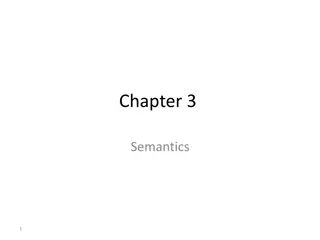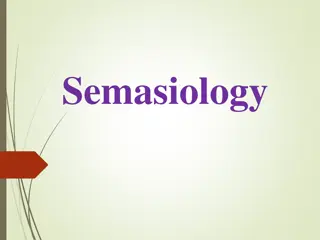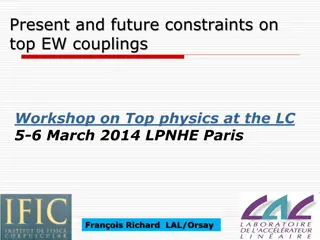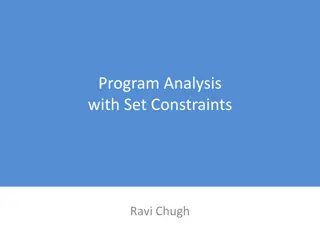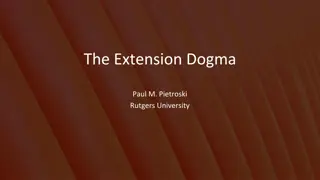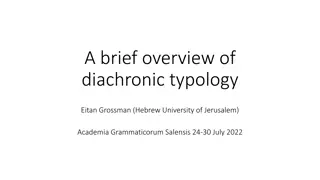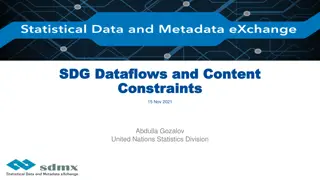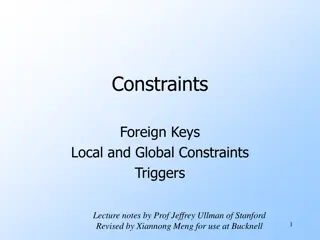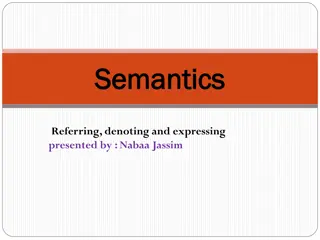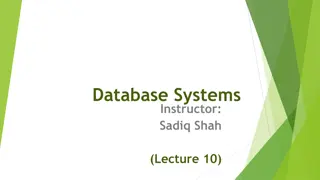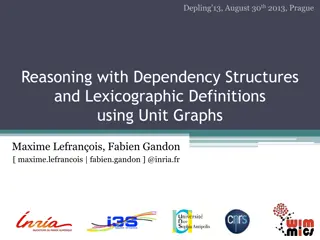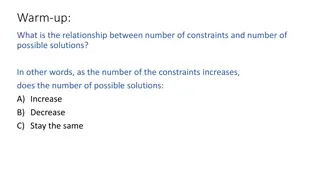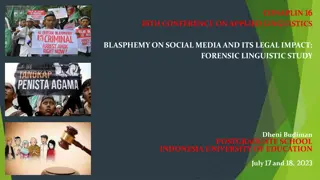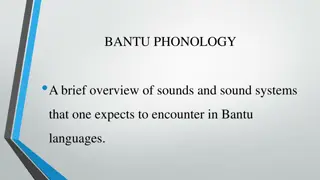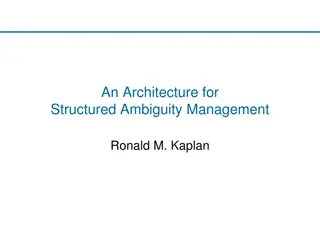Exploring Human Meaning Types and Linguistic Constraints
Delve into the exploration of human meaning types through linguistic expressions, constraints, and interpretations. Analyze diverse expressions that connect meanings with pronunciations based on certain constraints, highlighting the complexity and nuances of language acquisition and comprehension.
Uploaded on Sep 17, 2024 | 0 Views
Download Presentation

Please find below an Image/Link to download the presentation.
The content on the website is provided AS IS for your information and personal use only. It may not be sold, licensed, or shared on other websites without obtaining consent from the author. Download presentation by click this link. If you encounter any issues during the download, it is possible that the publisher has removed the file from their server.
E N D
Presentation Transcript
Locating Human Meanings: Less Typology, More Constraint Paul M. Pietroski, University of Maryland Dept. of Linguistics, Dept. of Philosophy
Elizabeth, on her side, had much to do. She wanted to ascertain the feelings of each of her visitors, she wanted to compose her own, and to make herself agreeable to all; and in the latter object, where she feared most to fail, she was most sure of success, for those to whom she endeavoured to give pleasure were prepossessed in her favour. Bingley was ready, Georgiana was eager, and Darcy determined to be pleased. Jane Austen Pride and Predjudice
Bingley is eager to please. #(b) Bingley is eager to be one who is pleased. (a) Bingley is eager to be one who pleases. Bingley is easy to please. #(a) Bingley can easily please. (b) Bingley can easily be pleased. Human children naturally acquire languages that somehow generate boundlessly many expressions that connect meanings (whatever they are) with pronunciations (whatever they are) in accord with certain constraints. 3
Human languages generate boundlessly many expressions that connect meanings with pronunciations in accord with certain constraints. Do human linguistic expressions exhibit meanings of different types? (1) Fido (2) chase (3) every (4) cat (5) every cat (6) chase every cat (7) Fido chase every cat (8) Fido chased every cat. And if so, which meaning types do they exhibit? 4
What are the Human Meaning Types? one familiar answer, via Frege s conception of ideal languages (i) a basic type <e>, for entity denoters (ii) a basic type <t>, for thoughts or truth-value denoters (iii) if < > and < > are types, then so is < , > Fido, Garfield, Zero, Fido barked. Fido chased Garfield. Zero precedes every positive integer. 5
What are the Human Meaning Types? one familiar answer, via Frege s conception of ideal languages (i) a basic type <e>, for entity denoters (ii) a basic type <t>, for thoughts or truth-value denoters (iii) if < > and < > are types, then so is < , > on the other hand, one might suspect (a) there are no meanings of type <e> (b) there are no meanings of type <t> (c) the recursive principle is crazy implausible 6
What are the Human Meaning Types? one familiar answer, via Frege s conception of ideal languages (i) a basic type <e>, for entity denoters (ii) a basic type <t>, for thoughts or truth-value denoters (iii) if < > and < > are types, then so is < , > That s a lot of types 7
a basic type <e>, for entity denoters a basic type <t>, for truth-value denoters if < > and < > are types, then so is < , > at Level 5, more than 5 x 1012 0. <e> <t> (2) types at Level Zero 1. <e, e> <e, t> <t, e> <t, t> (4) at Level One, all <0, 0> 2. eight of <0, 1> eight of <1, 0> (32), including <e, et> sixteen of <1, 1> and <et, t> 3. 64 of <0, 2> 64 of <2, 0> 128 of <1, 2> 128 of <2, 1> <e, <e, et>>; <et, <et, t>>; 1024 of <2, 2> (1408), including and <<e, et>, t> 4. 2816 of <0, 3> 2816 of <3, 0> 5632 of <1, 3> 5632 of <1, 3> 45,056 of <2, 3> 45,056 of <3, 2> 1,982,464 of <3, 3> (2,089,472), including <e, <e, <e, <et>> and <<e, et>, <<e, et>, t>
a basic type <e>, for entity denoters a basic type <t>, for truth-value denoters if < > and < > are types, then so is < , > 0. <e> <t> ziggy Number(ziggy) 1. <e, t> x.Number(x) 2. <e, et> y. x.Predecessor(x, y) y. x.Precedes(x, y) 3. <<e, et>, t> Intransitive[ y. x.Predecessor(x, y)] Transitive[ y. x.Precedes(x, y)] 4. <<e, et>, <<e, et>, t> TransitiveClosure[ y. x.Precedes(x, y), y. x.Predecessor(x, y)]
Frege invented a language that supported abstraction on relations Three precedes four. Three is something that precedes four. Four is something that three precedes. *Precedes is somerelat that three four. x.Precedes(x, 4) x.Precedes(3, x) R.R(3, 4) The plate outweighs the knife. The plate is something which outweighs the knife. The knife is something which the plate outweighs . *Outweighs is somerelat which the plate the knife. 10
a basic type <e>, for entity denoters a basic type <t>, for truth-value denoters if < > and < > are types, then so is < , > 3. <<e, et>, t> Transitive[ y. x.Precedes(x, y)] Precedes transits. 4. <<e, et>, <<e, et>, t> TransitiveClosure[ y. x.Precedes(x, y), y. x.Predecessor(x, y)] Precedes transits predecessor.
a basic type <e>, for entity denoters a basic type <t>, for truth-value denoters if < > and < > are types, then so is < , > 0. <e> <t> (2) types at Level Zero 1. <e, e> <e, t> <t, e> <t, t> (4) at Level One, all <0, 0> 2. eight of <0, 1> eight of <1, 0> (32), including <e, et> sixteen of <1, 1> and <et, t> 3. 64 of <0, 2> 64 of <2, 0> 128 of <1, 2> 128 of <2, 1> <e, <e, et>>; <et, <et, t>>; 1024 of <2, 2> (1408), including and <<e, et>, t> 4. 2816 of <0, 3> 2816 of <3, 0> 5632 of <1, 3> 5632 of <1, 3> 45,056 of <2, 3> 45,056 of <3, 2> 1,982,464 of <3, 3> (2,089,472), including <e, <e, <e, <et>> and <<e, et>, <<e, et>, t>
What are the Human Meaning Types? one familiar answer, via Frege s conception of ideal languages (i) a basic type <e>, for entity denoters (ii) a basic type <t>, for thoughts or truth-value denoters (iii) if < > and < > are types, then so is < , > a suggestion in the footnotes of On Semantics Filter Functionals: no < , > types where is non-basic <et, t> <e, <e, <e, <e, t>>> 13
What are the Human Meaning Types? one familiar answer, via Frege s conception of ideal languages (i) a basic type <e>, for entity denoters (ii) a basic type <t>, for thoughts or truth-value denoters (iii) if < > and < > are types, then so is < , > a suggestion less permissive than Filter Functionals No Recursion:no < , > types (1) a basic type <M>, for monadic predicates (2) a basic type <D>, for dyadic predicates (n) a basic type <N>, for N-adic predicates
What are the Human Meaning Types? one familiar answer, via Frege s conception of ideal languages (i) a basic type <e>, for entity denoters (ii) a basic type <t>, for thoughts or truth-value denoters (iii) if < > and < > are types, then so is < , > a suggestion much less permissive than Filter Functionals No Recursion:no < , > types (1) a basic type <M>, for monadic predicates (2) a basic type <D>, for dyadic predicates Minimal Relationality
Degrees of Semantic Relationality None: e.g., Monadic Predicate Calculi some M is (also) P Unbounded: e.g., Tarski-style Predicate Calculi Mx & Py & Syz & Rxw & Bzuv &
a Tarski-style Predicate Calculus permits Unbounded Adicity Brown(x) 1 Brown(x) & Dog(x) 1 Saw(x, y) 2 unbounded adicity, but no typology each expression (wff) is a sentence and each sentence is satisfied by all/some/no sequences of domain entities Dog(x) & Saw(x, y) 2 Dog(x) & Saw(x, y) & Cat(z) 3 Dog(x) & Saw(x, y) & Cat(z) & Saw(z, w) 4 Dog(Fido) & Saw(Fido, Garfield) 0 Between(x, y, z) 3 Quartet(x, y, z, w) 4 Between(x, y, z) & Quartet(w, x, y, x) 4 Between(x, y, z) & Quartet(w, v, y, x) 5 Between(x, y, z) & Quartet(w, v, u, y) 6 Between(x, y, z) & Quartet(w, v, u, t) 7
Degrees of Semantic Relationality None: e.g., Monadic Predicate Calculi some M is (also) P Some, but Less Than Unbounded Minimally Relational (maximally limited) Mildly Relational (severely limited) Bounded, but still pretty permissive Unbounded: e.g., Tarski-style Predicate Calculi Mx & Py & Syz & Rxw & Bzuv &
Plan for Rest of the Talk Characterize a notion of Minimally Relational Describe a Possible Language that is Minimally Relational and (correlatively) Minimally Interesting in this respect Suggest that while Human Meanings may be a little more interesting, they approximate Minimal Relationality End with reminders of some other respects in which Human Languages seem to be Minimally Interesting, and suggest that semantic typology is yet another case
Minimally Relational admit dyadic predicates, but no predicates of higher adicity ABOVE(_, _) and CAUSE(_, _) are OK; so is AGENT(_, _) SELL(_, _, _, _) and BETWEEN(_, _, _) are not-OK admit relational notions only in the lexicon BETWEEN(_, _, JIM) is not-OK ON(_, _) & HORSE(_) is not-OK correspondingly limited combinatorial operations if ON(_, _) and HORSE(_) combine, the result is monadic combining lexical items cannot yield relational notions
We can imagine a language whose expressions are limited to (1) finitely many atomic monadic predicates: M1(_) Mk(_) (2) finitely many atomic dyadic predicates: D1(_, _) Dj(_, _) (3) boundlessly many complex monadic predicates Monad + Monad Monad BROWN(_) + HORSE(_) BROWN(_)^HORSE(_) FAST(_) + BROWN(_)^HORSE(_) FAST(_)^BROWN(_)^HORSE(_) 21
We can imagine a language whose expressions are limited to (1) finitely many atomic monadic predicates: M1(_) Mk(_) (2) finitely many atomic dyadic predicates: D1(_, _) Dj(_, _) (3) boundlessly many complex monadic predicates Monad + Monad Monad for each entity: (_)^ (_) applies to it if and only if (_) applies to it, and (_) applies to it 22
We can imagine a language whose expressions are limited to (1) finitely many atomic monadic predicates: M1(_) Mk(_) (2) finitely many atomic dyadic predicates: D1(_, _) Dj(_, _) (3) boundlessly many complex monadic predicates Monad + Monad Monad Dyad + Monad Monad ON(_, _) + HORSE(_) [ON(_, _)^HORSE(_)] |_______ for each entity: (_)^ (_) applies to it if and only if (_) applies to it, and (_) applies to it |_________| (thing that is) on a horse
We can imagine a language whose expressions are limited to (1) finitely many atomic monadic predicates: M1(_) Mk(_) (2) finitely many atomic dyadic predicates: D1(_, _) Dj(_, _) (3) boundlessly many complex monadic predicates Monad + Monad Monad Dyad + Monad Monad ON(_, _) + HORSE(_) [ON(_, _)^HORSE(_)] for each entity: (_)^ (_) applies to it if and only if (_) applies to it, and (_) applies to it (thing that is) on a horse # thing that a horse is on 24
We can imagine a language whose expressions are limited to (1) finitely many atomic monadic predicates: M1(_) Mk(_) (2) finitely many atomic dyadic predicates: D1(_, _) Dj(_, _) (3) boundlessly many complex monadic predicates Monad + Monad Monad Dyad + Monad Monad for each entity: for each entity: [ (_, _)^ (_)] applies to it if and only if it bears to something that (_) applies to (_)^ (_) applies to it if and only if (_) applies to it, and (_) applies to it 25
[AGENT(_, _)^HORSE(_)]^EAT(_)^FAST(_) is like e[AGENT(e , e) & HORSE(e)] & EAT(e ) & FAST(e ) [AGENT(_, _)^FAST(_)^HORSE(_)]^EAT(_) is like e[AGENT(e , e) & FAST(e) & HORSE(e)] & EAT(e )] We don t need variables to capture the meanings of horse eat fast and fast horse eat . 26
SEE(_)^[THEME(_, _)^HORSE(_)] is like SEE(e ) & e[THEME(e , e) & HORSE(e)] SEE(_)^ [THEME(_, _)^ [AGENT(_, _)^HORSE(_)]^EAT(_)] is like SEE(e ) & e [THEME(e , e ) & e[AGENT(e , e)^HORSE(e)] & EAT(e )] We don t need variables to capture the meanings of see a horse and see a horse eat . 27
What are the Human Meaning Types? --two basic types, <e> and <t> --endlessly many derived types of the form < , > --a monadic type <M> --a dyadic type <D>, for finitely many atomic expressions -- <M> + <M> <M> <M> + <D> <M> -- < > can combine with < , > to form < > 28
Can Human Lexical Items have Level Four Meanings? a linguist sold a car to a friend for a dollar (sold a friend a car for a dollar) whatever the order of arguments, the concept SOLD, which differs from GAVE, is plausibly (at least) tetradic 29
Can Human Lexical Items have Level Four Meanings? So why not a linguist sold a car a friend a dollar x sold y this z w him (she that) y. z . w. x . x sold y to z for w 30
Can Human Lexical Items have Level Four Meanings? Z . Y. X . GLONK(X, Y, Z) x[X(x) v Y(x) v Z(x)] x[X(x) & Y(x)] & x[Y(x) & Z(x)] Glonk cat friendly dog 31
Can Human Lexical Items have Level Three Meanings? <t> <e, t> FIDO<e>CHASED(_, _)<e, <e, t>> GARFIELD<e> <t> <e, t> <e, et> ROMEO<e>GAVE(_, _)<e, <e, <e, t>> GARFIELD<e> JULIET<e> 32
but double-object constructions do not show that verbs can have Level Three Meanings Romeo gave it to Juliet Romeo kicked Romeo kicked Juliet the rock the rock to Juliet
Why not instead a thief jimmied a lock a knife (x) (y) (z) he jimmied it that jimmied z. y . x . x jimmied y with z The concept JIMMIED is plausibly (at least) triadic. So why isn t the verb of type <e, <e, <et>>>?
Why not a rock betweens a lock a knife (x) (y) (z) betweens z. y . x . x is between y and z
Still, one might think that many verbs do have Level Three Meanings <t> <et> -ED(_)<et, t> FIDO<e>BARK(_, _)<e, et> <et> <e, et> FIDO<e>CHASE(_, _)<e, <e, et>> GARFIELD<e> 37
Can Human Lexical Items have Level Three Meanings? <e, et> <<e, et>, <e, et>> <et, > <e, et> INTO-A-BARN<et> CHASE(_, _)<e, <e, et>> GARFIELD<e> THE-SENATOR<e>FROM-TEXAS<et> Saying that expressions of type <e, et> can be modified by expressions of type <et> is like positing a covert Level 4 element. And why does the modifier skip over the thing chased, applying instead to the chase? 38
if the meaning of chase is at Level Three, then a passivizer would also be at Level Four: <<e,<e, et>, <e, et>> <e, et> Garfield was chased <e,<e, et>> Kratzer and others sever agent-variables from verb meanings: <et> <e, et> chase y. e . e is a chase of y Garfield was chased <e, et>> <e>
<et> <e, et> FIDO<e> <et, <e, et>> <et> active voice head Level Three <et> INTO-A-BARN<et> CHASE(_, _)<e, et>> GARFIELD<e> But if the posited verb meaning is below Level Three, do we really need the covert Level Three element? 40
<et> <et> <e, et> AGENT FIDO<e> <et> <et> INTO-A-BARN<et> CHASE(_, _)<e, et>> GARFIELD<e> 41
What are the Human Meaning Types? one familiar answer, via Frege s conception of ideal languages (i) a basic type <e>, for entity denoters (ii) a basic type <t>, for thoughts or truth-value denoters (iii) if < > and < > are types, then so is < , > but is it independently plausible that some of our human linguistic expressions have meanings of type <e>? -- proper nouns like Tyler , Burge , and Pegasus ? -- pronouns like he , she , it , this , that ? we know how to Pegasize, and treat names as special cases of monadic predicates 42
What are the Human Meaning Types? one familiar answer, via Frege s conception of ideal languages (i) a basic type <e>, for entity denoters (ii) a basic type <t>, for thoughts or truth-value denoters (iii) if < > and < > are types, then so is < , > but is it independently plausible that some of our human linguistic expressions have meanings of type <t>? -- which ones? VPs, TPs, CPs? -- pronouns like he , she , it , this , that ? we know (via Tarski) how to treat sentences as special cases of monadic predicates 43
Do Human i-Languages have expressions of type <t>? S NP aux VP Why think the tense morpheme is of type <et, t> T(P) / \ T past D(P) V(P) John / \ Why think tensed phrases denote truth values? e . e is (tenselessly) a John-see-Mary event V(P) / \ V D(P) see Mary E . e[Past(e) & E(e)] e . Past(e) as opposed to <et> or <M> 44
Do Human i-Languages have expressions of type <t>? Why think the tense morpheme is of type <et, t> T(P) / \ T past D(P) V(P) John / \ e . e is (tenselessly) a John-see-Mary event V(P) / \ V D(P) see Mary a quantifier | E . e[Past(e) & E(e)] that is also a conjunctive adjunct to V? 45
Kinds of Quantifiers Kinds of Predicates: Propositional Calculus 0 1 (monadic) 2 3 (dyadic) 4 unbounded adicity & Syz & Rxw & Bzuv & Mx & Px Rxy Mx & Py
Minimally Relational Second-Order Systems Mildly Relational Second-Order Systems Church s -Calculus (maybe typed a la Frege, and limited to a few Lower Levels ) Kinds of Quantifiers: Quantification over Relations Second-Order Quantification over Properties Sold(x, y, z, w) Tarskian Predicate Calculus Aristotelian Syllogisms First-Order Between(x, y, z) Cause(x, y) Kinds of Predicates: Propositional Calculus: complete sentences (truth-table conjunction) 0 1 (monadic) 2 3 (dyadic) 4 unbounded adicity
Plan for Rest of the Talk Characterize a notion of Minimally Relational Describe a Possible Language that is Minimally Relational and (correlatively) Minimally Interesting in this respect Suggest that while Human Meanings may be a little more interesting, they approximate Minimal Relationality End with reminders of some other respects in which Human Languages seem to be Minimally Interesting, and suggest that semantic typology is yet another case
Flavors of Recursion Some recursive procedures are very, very, ... , very boring Others generate more interesting [phrases [within [phrases [within [phrases ]]]]] And some allow for displacement of a sort that permits construction of relative clauses like who saw Juliet and who Romeo saw , whose elements can be systematically recombined to form boundlessly many expressions that allow for displacement
very boring are procedures Some recursive N phrases NP N P within PP P NP PP within NP within N within phrases NP N PP NP N within phrases phrases within phrases S NP aux VP Romeo did see Juliet Romeo saw Juliet Romeo saw who who Romeo saw t CP


